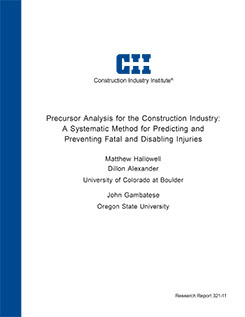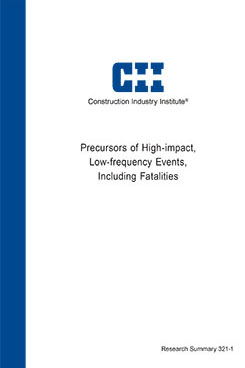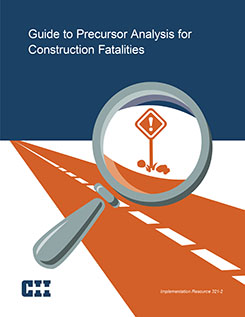
Precursor Analysis for the Construction Industry: A Systematic Method for Predicting and Preventing
In 2015 the United States Bureau of Labor Statistics (BLS) released the 2013 census data for work-related fatalities, injuries, and illnesses (BLS 2015). Construction recorded the highest number of fatalities of any industry, with a total of 856 Tragically, this marks the highest number of fatalities in the construction industry since 2009 and, more importantly, highlights the growing concern that the fatality rate in construction has recently plateaued. Similar observations have been made of Construction Industry Institute (CII) data. As these data suggest, there is a need for new injury prevention methods that focus purely on the fatalities that continue to plague the industry. Enhancing traditional safety methods and using leading information to predict and prevent catastrophic fatalities is a logical next step for the industry.
One of the challenges of analyzing fatal and disabling injuries is that they (fortunately) occur infrequently in comparison to less severe events. The infrequent nature of fatal events makes it especially difficult to identify latent factors and analyze causal trends. Researchers have expressed frustration in this regard, questioning why devastating fatal incidents continue to occur in the construction industry given the amount of investigation and analysis that has taken place and our current level of safety knowledge (Wu et al. 2010). Fortunately, other industries that rely on the prevention of infrequent and catastrophic events have found a successful strategy to manage rare, high-impact events: precursor analysis.
Similar to the National Academy of Engineering (2004), we define a precursor as a reasonably detectable event, condition, or action that serves as warning signs to a fatal or disabling injury. Precursor analysis was first introduced following the Three Mile Island nuclear plant meltdown of 1979 (Minarick, 1990). Other industries such as aviation, chemical manufacturing, and pharmaceuticals, and the National Aeronautical and Space Agency’s (NASA) space program have all since created specific precursor analysis programs (National Academy of Engineering, 2004). Although precursors from some industries may not be directly translatable to other industries, the precursor identification and analysis processes are fundamentally similar. Further, since we are focused on high-impact, low-frequency (HILF) events, we define them as high-energy events that result in or have the potential to result in a fatality or life-altering injury or illnesses and precursors as reasonably detectable events, conditions, or actions that serve as warning signs of an event.
Our goal in the present study was to create an empirically validated precursor analysis method for HILF events. In pursuit of this goal, we established the following objectives:
- Identify and document causal factors of construction fatalities;
- Translate the list of factors into a series of leading questions that can be asked in the field;
- Apply the precursor questionnaire to collect responses for cases of successful work (no incident) and failed work (fatality, injury, or near miss);
- Conduct a controlled experiment to measure the extent to which the data collected via the protocol and judgment can be used together in a leading and predictive fashion to distinguish between success and failure; and
- Measure the generalizability of the method by repeating the experiment with multiple groups with varying degrees of industry experience.
- Create a mathematical model that objectively predicts the probability that a work scenario will result in a HILF event.
- Validate the predictive model using new cases.



